The Library as Incubator Project wants YOU to look at Programming as Collection Development
In Brief: The Library as Incubator Project is a web-based project that seeks to promote and facilitate creative collaboration between libraries and artists of all types, and to advocate for libraries as incubators of the arts. Through founding and maintaining the project, we began to see that not all knowledge worth collecting for a library was written down – much of the creative skills and expertise of artists and makers in the community was only accessible by talking and learning from them. The best way to collect this information is through partnerships and programming – “programming as collection development.” Several libraries lead the way in this new concept of collecting information, and the evolution of library makerspaces has ushered in more and more opportunities to partner with local artists and makers. Most importantly, every library must look to its own community to build an individual collection of local skills and knowledge.
By Katie Behrens, Erinn Batykefer, and Laura Damon-Moore
Our Beginnings
The genesis of the Library as Incubator Project was innocuous: it was a question without an answer.
Co-founders Erinn Batykefer, Laura Damon-Moore, and Christina Endres met during their first semester of coursework in the Master’s program at the University of Wisconsin-Madison School of Library and Information Studies in the fall of 2010. Our very first course was a broad overview that introduced the bedrock philosophies of library service. A lecture by one of our professors, Dr. Louise Robbins, on the importance of creative advocacy for libraries got all of us excited about innovative ways to show a community what the library does and can do.
What followed was one of the most exciting conversations we had in the class: it focused on advocacy and creative ways to make sure a community understands the work and the value of the library. We discussed targeting advocacy campaigns to particular user groups in order to create personalized profiles of what the library could do for children, job seekers, English language learners, seniors, and other groups. Then Laura introduced a group of library users not usually included in that list: artists. In her work for the UW-Madison Friends of the Libraries Newsletter, Laura had written a piece about a local artist named Martha Glowacki whose art installation pieces were strongly influenced by library research—so much so that they wouldn’t exist without the library.
Afterward, we wondered about artists as a user group—did they use the library as Martha did? Were their needs met? What did they need from library spaces and resources that were different than other people? Laura holds a degree in acting and Erinn is a published poet, and we had our own ideas about how libraries were useful for creative work, but had anyone written about it?
After some research, we realized we couldn’t find anything about artists in the academic library literature, so we set out to answer these questions ourselves. During a one-credit Independent Study course, we designed a qualitative survey and sent it to over 100 artists, writers, makers, and librarians in the Madison area. We wanted to know if artists used their local library (or any library, for that matter), how they used libraries, and what kinds of services they’d like to see from libraries. We were blown away by the response: not only do libraries play a huge role in a lot of artists’ work and creative process, but in so very many different ways! We heard everything from “I found books that inspired me” to “I actively seek out library resources to help with project research” to “I love working in the hushed quiet of a library.
In the survey, we also asked artists, “What does the phrase “library as incubator” mean to you?” Almost everyone latched on to our language to describe libraries as a place to nurture creative ideas from beginning to completion, like an incubator nurtures eggs to become chicks. It seems like a strange word choice, but the name stuck as the most fitting way to capture the idea. The results of our survey surprised us, and we knew we had to share what we learned – we knew this could change how libraries serve both the artists in their communities and everyone else, too.
And then our world exploded with the massive Wisconsin budget protests of early 2011. The state budget was undergoing a significant restructuring, which included substantial cuts to libraries and prominent publicly funded arts organizations. At that point, we started to realize that our grand idea—the idea of promoting the library-as-arts-incubator—might be more than just a pet project for a trio of library school students. We realized that libraries functioning as arts incubators could provide the spaces and materials necessary to sustain the artistic and creative work of writers, illustrators, painters, photographers, poets, playwrights, and performing artists of all kinds when local and state governments took an axe to the arts budget. We saw real potential for libraries to come to the fore as arts incubators in the same way that they have become necessary job-search hubs by providing Internet access, resume workshops, and professional development materials for many, many job seekers during this recession.
So we hatched plans to spread the word about libraries and artists to the world. We needed a central hub where anyone could find and share stories about library arts incubation, and in the digital information age, that meant a website. The Library as Incubator Project officially launched in October of 2011, and it has grown beyond our wildest imaginings. At first, we used the website to share the answers that artists had provided to our survey along with their work, and solicited new content from artists and libraries. But we wanted to share more artist interviews, more digital collections, and more ideas from libraries about the partnerships and programs they developed that not only support artists, but also connect them to the community by sharing their skills and their work. We knew artists were already using libraries as arts incubators; we wanted the site to collect as many accounts of that relationship as we possibly could so that the Library as Incubator Project could become a resource and an advocacy tool.
Almost two years later, our mission hasn’t changed: to promote and facilitate creative collaboration between libraries and artists of all types, and to advocate for libraries as incubators of the arts.
We also started building a social media presence in order to engage with a broad audience of artists and libraries. The response since we launched has been amazing. We’ve heard from libraries and artists from all across the United States and all over the world: from Qatar, New Zealand, Australia, Britain, and elsewhere. Clearly, there is a need for the library-as-incubator idea, and we’re grateful for the opportunity to help meet that need. It’s why we continue to volunteer our time for the project, why we take on new writers and interns to help us keep the content on the site and on social media new and engaging, and why the Project is still going strong even as we have graduated and moved on to jobs in the library world.
Programming as Collection Development – a New Concept?
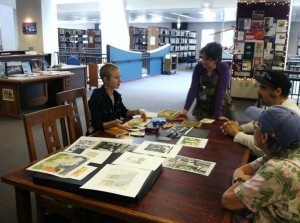
A woodcut artist demonstrates her work at the Rochester Public Library as part of their “Caution! Artist @ Work!” series.
The Library as Incubator Project began by looking at artists as a library user group and how a library could best serve that population. However, it quickly morphed to include stories about libraries forming great relationships with local artists and utilizing them to provide innovative programming. Think about it: if you know there’s a local painter who uses the library for inspiration or work space, ask that painter if she would be interested in teaching some basic painting classes in the library. It’s a win-win situation: the painter has a captive and interested classroom to teach, and the librarians don’t have to learn how to teach painting. Also, you’ve strengthened a tie in your community. Some would call this community engagement or outreach, but we began to wonder: what if this kind of programming was actually an extension of collection development?
What if you could collect the intangible skill-knowledge of an artist just like you collect a book, DVD, or database – not by writing down his knowledge but by partnering with him?
A wild concept, we know, but hear us out. There are many facets to the mission of the library as an institution—serving the public, providing resources, promoting literacy, acting as a cultural repository–but all of these facets contribute to a single goal: connecting people with information. When information was written on scrolls, the Library of Alexandria kept scrolls for scholars to use. When the codex (the rectangular, bound book) became the most useful form in which to store information, libraries began collecting books. With the rise of electronic resources and databases, libraries make that information accessible to patrons. However, all of these examples relate only to information that has been written down or recorded in some way. What if the information most needed by a patron is not recorded information, but rather information contained in someone else’s head?
There are artists, makers, and craftspeople in your community who know a great deal about their craft. That information or knowledge may not exist in a book or online video tutorial. It exists in the mind of the maker, and we at the Library as Incubator Project believe that it is just as much the duty of the library to “collect” that knowledge through partnerships and programming as it is to purchase new books for the shelves. The process of collecting this information is something we call “programming as collection development;” it provides makers with a way to connect and share their knowledge with the rest of the community, and the community a chance to explore something that cannot be found in books.
Makers, Makerspaces, and How They Connect
The Incubator focuses on promoting arts programming and partnerships in libraries, but we’ve found that because art is so closely tied to creativity—and creativity so closely tied to maker culture—that it’s often difficult and unproductive to separate the arts from making. It’s worth taking a step back to look at maker culture in order to see how well it fits with the mission of the library.
The terms “maker” and “maker culture” were coined by Dale Dougherty, founder of MAKE Magazine and creator of Maker Faire, to encompass all different kinds of creative individuals. One doesn’t have to be just a seamstress or a home brewer or someone who likes tinkering with electronics anymore – now you can identify as a “maker.” “Maker culture” refers to the whole ethos and process of fiddling, tinkering, experimenting, failing, reworking, recycling, upcycling, hacking, and creating. Maker culture does not depend on a perfect setting or dedicated space. It’s a way of looking at the world, creatively testing the boundaries and playing with what you have. The larger world has noticed the growing trend, too. Back in 2009, the Wall Street Journal pointed to a comeback in tinkering during the economic recession, and a year later, National Public Radio ran a story about tinkering, which introduced listeners to several well-known makerspaces across the country.
You may have noticed that maker culture has taken the library world by storm in recent years, and it seems like everyone (public libraries, academic libraries, archives & special collections, etc.) is stumbling over themselves to fund the purchase of a 3D printer or laser cutter. Makerspaces, hack(er)spaces, Fab Labs—terms that were previously only known to the maker subcultures–are now thrown around with relative ease at library conferences and on librarian blogs. It’s all very exciting, but it’s also moving very fast. It has the feeling of a trend or fad, and any good librarian has to wonder: is this makerspace thing really where our attention should be focused?
Our answer? Yes! …with some clarification.
Author Cory Doctorow is an outspoken advocate for both libraries and maker culture, so we know we’re not the lone voice in this debate. In a guest post for Canadian book distributor Raincoast Books, Doctorow points out that makers are proponents of free and accessible information, just like librarians. Makers are also in the business of lifelong learning, just like libraries, but usually through doing rather than reading. So when it comes to common missions and goals, makers and libraries are on the same road.
Most libraries, at least public libraries, are already engaging in maker culture with knitting clubs, “crafternoons,” LEGO clubs, workshops on composting, fermenting, cooking, and other DIY mainstays, and of course, children’s story times. All of these programs are well and good on their own, but they only scratch the surface of where the library mission and maker culture meet.
As far as materials sharing, makerspaces fit right in with the mission of the library. Libraries own books and databases for people to share, so why not a 3-D printer? Non-library makerspaces and workshops in the community have been operating as a tool-share for years. After all, not everyone can own a table saw. And yet, community makerspaces are so much more than a communal tool bench. As a member of a makerspace like Pumping Station: One in Chicago, you have access to the tools and the skills and knowledge of everyone else around you. The skills and knowledge that are behind craftsmanship and artistry – this is the unwritten information that libraries should begin to collect through outreach and partnerships.
Selected Examples
Thankfully, as our friend Lavar Burton used to say, you don’t have to take my word for it. In a recent feature on NPR, American Library Association president Barbara Stripling made reference to libraries that loan people: “There are people in the community who say, ‘I’m an expert at electronics or plumbing. So put me in the catalog. If somebody has a question that I can help answer, they can check me out.” That’s precisely what we’re getting at: collecting teachable skills and knowledge, in the form of community members, just like you’d collect other materials (you know, without objectifying any human person). Libraries across the country have been putting this idea of “programming as collection development” to work, and we’ve seen it most clearly through the development of library makerspaces. Carnegie Library of Pittsburgh (PA) and Madison Public Library (WI) are some of the best examples.
The Labs at the Carnegie Library of Pittsburgh, CLP’s teen makerspace, turned to experts in the community to provide exciting, creative, and tech-focused activities for their young adults. Programs include everything from a DJ-ing workshop in collaboration with a local DJ and an organization called Hip Hop on LOCK, to tapping the talent and expertise of the Pittsburgh Filmmakers collective for filmmaking workshops. Partnering with local groups and individuals means that library staff aren’t under pressure to learn everything about every topic the teen users might be interested in, and teens are excited about the prospect of working with experts in the fields that mean something to them. They also learn valuable digital skills by applying them to personal projects. In this way, their learning is driven by their passion, not a curriculum. (click here for more recent updates)
Madison Public Library in Madison, Wisconsin, taps into its community to engage patrons of all ages with its new program series called The Bubbler. The Bubbler leverages the sizable community of creative businesses and individuals found in this university town to provide a menu of hands-on programs that range from poetry readings to art shows to screen-printing and stop-motion animation workshops. The Bubbler (unlike other library makerspaces) does not have a permanent base in the library but instead is made up of a network of satellite or pop-up locations in library branches and other cultural institutions (an art museum, for example) all over Madison. MPL’s The Bubbler recently won a National Endowment for the Arts Our Town grant to help expand the programming calendar and build foundational partnerships.
The Labs and The Bubbler are examples of libraries that curate local know-how to offer a rich slate of programs for their users. Working with local individuals, organizations, and businesses as programming partners relieves library staff of having to plan, prep, and facilitate programs that they might not feel qualified to lead, or have the time to do well. These partnerships are not one-sided, either—the community partners benefit from the exposure they receive at the library, and patrons are more likely to come back because they have a chance to try out a new skill with no risk involved.
Although we’ve stressed local skills and expertise up until this point, “programming as collection development” applies to local content creation as well. There are several notable examples of libraries that intentionally collect community-created content, such as music by local bands and a collection of poetry by local writers. We’ve been able to highlight a number of these projects on the Library as Incubator Project website in an effort to draw attention to the importance and benefit of creating access to community content and opening up a broader dialogue on the library as a place where one can not only access and consume information, but also create it.
Iowa City Public Library recently launched a new digital music collection called the Local Music Project. Through the Project, the library leases the rights to records by local musicians, which cardholders from Iowa City and the library’s service partners can then download and keep–for free. There are currently fifty-eight albums available on the Local Music Project page, and more on the way.
This exciting new service model started with a common problem: the library needed a new way to deliver music to patrons. CDs have high loss rates and many borrowers simply take them home and rip the music. In order to keep things legal and reduce the amount of theft that plagues AV collections, the library began looking into digital options, and the Local Music Project began to take shape.
They created a contract with the help of the city’s lawyer, and then ventured out into Iowa City’s music scene to sign bands and negotiate license fees.
Sacramento Public Library is home to a wonderfully integrated program that supports local writers of all kinds: the I Street Press Community Writing and Publishing Center. Funded by grants from the Institute of Museum and Library Services and the California State Library, the Sacramento Public Library is re-inventing library service to their community with an Espresso Book Machine designed to print on demand, a massive online database of printable books (many of them out of print), and an integrated suite of writing workshops to teach writing craft and guide interested patrons through the process of self-publishing.
In addition to printing on demand and writing workshops, the Library is also growing an impressive Local Authors Collection with the help of I Street Press. When a patron decides to self-publish her work through I Street, she has the option to donate a copy to the library. The book is then catalogued, and added to the Local Authors Collection at the central library. The titles are included in the system’s 28-branch catalogue as well, and are available to everyone in the area with a library card!
Practical Application – What Can YOU Do?
At the Library as Incubator Project, we know that in order for libraries to become true incubators for creative artists, we can’t very well say that librarians must all become arts educators, literary agents, and arts administrators. Rather, we encourage libraries to fulfill and in some cases expand their role as community information organizers and providers—tapping in to the arts educators, the editors and writers, the community theater and music groups who want to engage with their community as much as the community wants to engage with them. These partnerships can be maintained at a very low cost to the library and provide high-quality programs that are meaningful for both the facilitators and the participants because they are all part of the same community.
For example, you don’t have to know a thing about Arduino to bring in someone from your community to teach a class on it. Whether or not you’re able to pay them depends entirely on your library, but most librarians have found that community members are more than happy to share their passion with others for free. In all of our features and interviews, we have found this to be especially true of artists. Local artists love to share their work and their passion with a wider audience. A lot of people won’t set foot in an art gallery, but they’ll at least look at an exhibition hanging on the library’s walls. The library is a kind of neutral space that can act as a “meeting of the minds.” Academic libraries have convinced engineering departments to share their 3D printers, computer science departments to share their programming computers, and art departments to share their design expertise. Disciplines can meet in the neutral crossroads of the library space, learn from each other, and make new connections. Everyone wins.
Obviously, partnering with individuals and businesses in one’s community is not a new idea for most libraries. What may be a new idea is approaching programming as an integral aspect of collection development and devoting the same attention and intentionality to program planning as one does to managing a collection of print and digital materials. When the library provides a space for users to engage with their community in a very hands-on, personal way, it becomes a true hub of community knowledge and skill sharing.
So. Programming as Collection Development: are you on board yet? It’s a surprisingly simple concept – not all useful knowledge to be collected is written down, and one collects that human knowledge through library programs and partnerships – but we’ve tried to cover it from multiple angles. The most important point about this mentality, and we can’t stress this enough, is to know and rely upon your own community. Every community will have a different culture, and no one should feel any pressure to duplicate another library’s programming. When a librarian develops a collection of materials for her library, she taps into the local tastes and values. When looking for a place to start collecting through programs, use local expertise and knowledge. Is there a group in your city that fixes up broken bikes for fun? Invite them to teach a bike clinic in the library! Perhaps you know of a community member that silk screen prints her own t-shirts; ask her to lead a program! Or maybe you need to seek out someone in your community who embodies the maker spirit. He’ll probably be game for anything. The possibilities are, quite literally, endless.
What do you think about “programming as collection development”? Is this a revitalizing idea, or simply a repackaging of what you’ve done for years? How would you go about collecting skills and expertise in your community? Do you know of any libraries pursuing this kind of programming? We’d love to hear your comments and discussion below – let us know what you think!
If you’d like more information on who we are and what we do, visit us online at the Library as Incubator Project website, or follow us on Twitter, Facebook, and Pinterest.
In the coming months, look for the launch of our sister-site, the Book to Art Club, which will provide arts-incubating librarians with easy, downloadable book club templates that include hands-on activities designed to expand and enrich participants’ experience of the books they read. If you want to pilot the Book-to-Art club at your library, please get in touch!
And don’t miss our upcoming book from Coffee House Press called “The Artist’s Library,” which will be published in Spring 2014. (Check out the official Press Release HERE.)
Acknowledgements
A special thanks to our team members, Holly Stork-Post and Angela Terrab, for listening to us we circled around this topic endlessly in the past few months and for reading drafts. You’re the best!
A HUGE thank you to our editors at In the Library with a Lead Pipe. Our first draft was a stinker, and your wise suggestions made it 10,000 times better. Really, if we could send you chocolates and flowers, we would!
Resources & References
From the Library as Incubator Project website
Batykefer, Erinn. (2012, Oct 18). “Cyanotype workshops at Madison Public Library.” The Library as Incubator Project. Retrieved at http://www.libraryasincubatorproject.org/?p=7030
Batykefer, Erinn. (2012, Mar 30). “I Street Press: A community writing & publishing center.” The Library as Incubator Project. Retrieved at http://www.libraryasincubatorproject.org/?p=3856
Batykefer, Erinn. (2012, July 5). “Iowa City Public Library’s Local Music Project.” The Library as Incubator Project. Retrieved at http://www.libraryasincubatorproject.org/?p=5056
Damon-Moore, Laura. (2012, Oct 8). “What we mean by “incubator”.” The Library as Incubator Project. Retrieved from http://www.libraryasincubatorproject.org/?p=5966
Fear, Emily. (2012, June 29). “The Labs @ Carnegie Library of Pittsburgh.” The Library as Incubator Project. Retrieved at http://www.libraryasincubatorproject.org/?p=5184
From elsewhere on the web
Blair, Elizabeth. (2013, Aug 13). “Beyond books: Libraries lend fishing poles, pans and people.” National Public Radio. Retrieved at http://www.npr.org/2013/08/13/211697593/beyond-books-libraries-lend-fishing-poles-pans-and-people
Doctorow, Cory. (2013, Feb 24). “Libraries, hackspaces and e-waste: How libraries can be the hub of a young maker revolution.” Raincoast Books (blog). Retrieved at http://www.raincoast.com/blog/details/guest-post-cory-doctorow-for-freedom-to-read-week/
Hidalgo, Jason. (2012, Oct 19). “The future of higher education: reshaping universities through 3D printing.” Engadget. Retrieved at http://www.engadget.com/2012/10/19/reshaping-universities-through-3d-printing/
Kalish, Jon. (2010, Nov 21). “DIY ‘hackers’ tinker everyday things into treasure.” National Public Radio. Retrieved from http://www.npr.org/2010/11/12/131268511/diy-hackers-tinker-everyday-things-into-treasure
Lahart, Justin. (2009, Nov 13). “Tinkering makes comeback amid crisis.” Wall Street Journal. Retrieved from http://online.wsj.com/article/SB125798004542744219.html


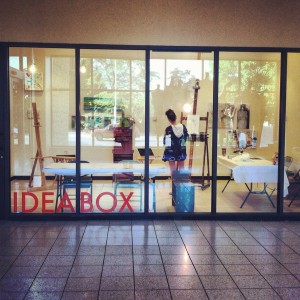
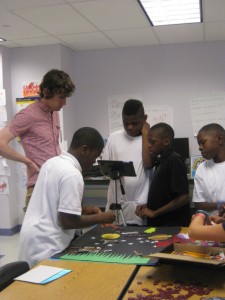
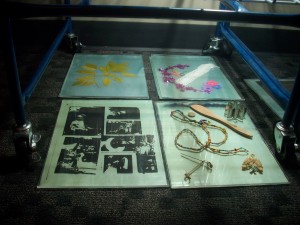
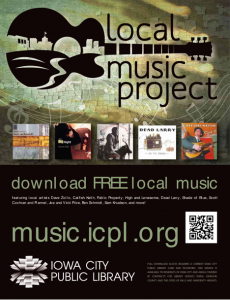
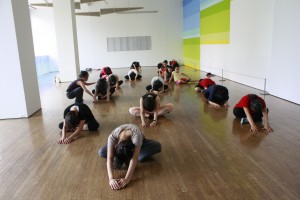
The Library as Incubator Project wants YOU to look at Programming as Collection Development http://t.co/sRS5MgXLVR Recherche, participation
RT @katreeeena: The Library as Incubator Project wants you to look at Programming as Collection Development (via @Pocket) http://t.co/iYKp…
MT @IArtLibraries: Are programming & collection development mutually exclusive? No way! See more at @libraryleadpipe http://t.co/eZSYnZNPbq
The Library as Incubator Project on Programming as Collection Development via @libraryleadpipe (http://t.co/eYOyQgZxQj)
RT @IArtLibraries: Join the conversation on “Programming as Collection Development” @libraryleadpipe http://t.co/KqUGnkiWbi What do you thi…
The Library as Incubator Project wants YOU to look at Programming as Collection Development » http://t.co/lRdciprNNE